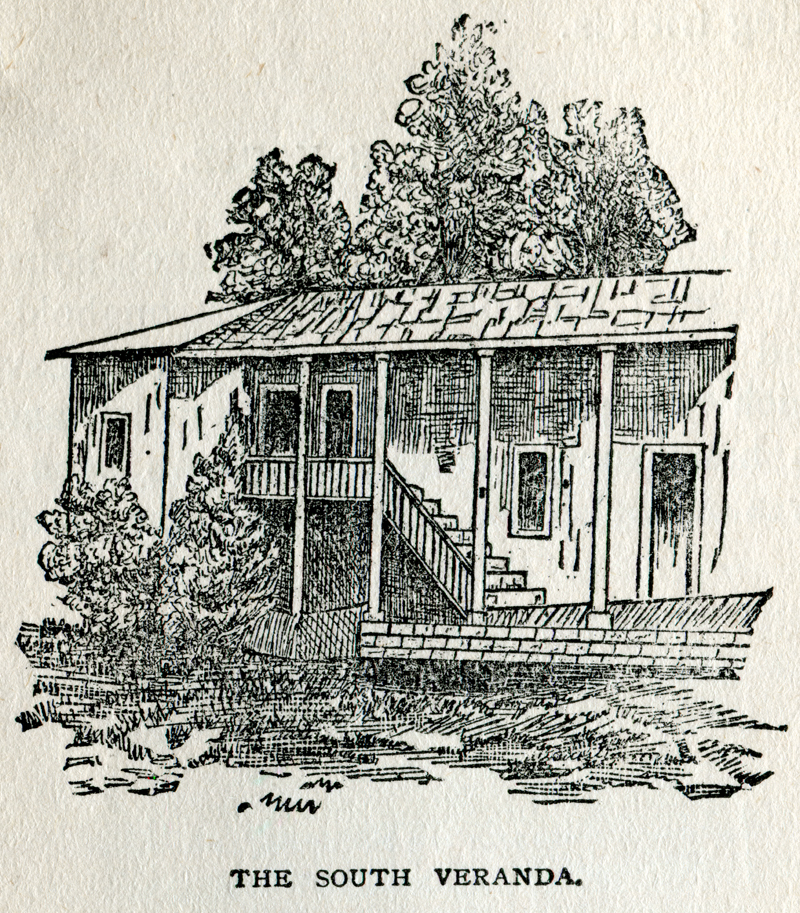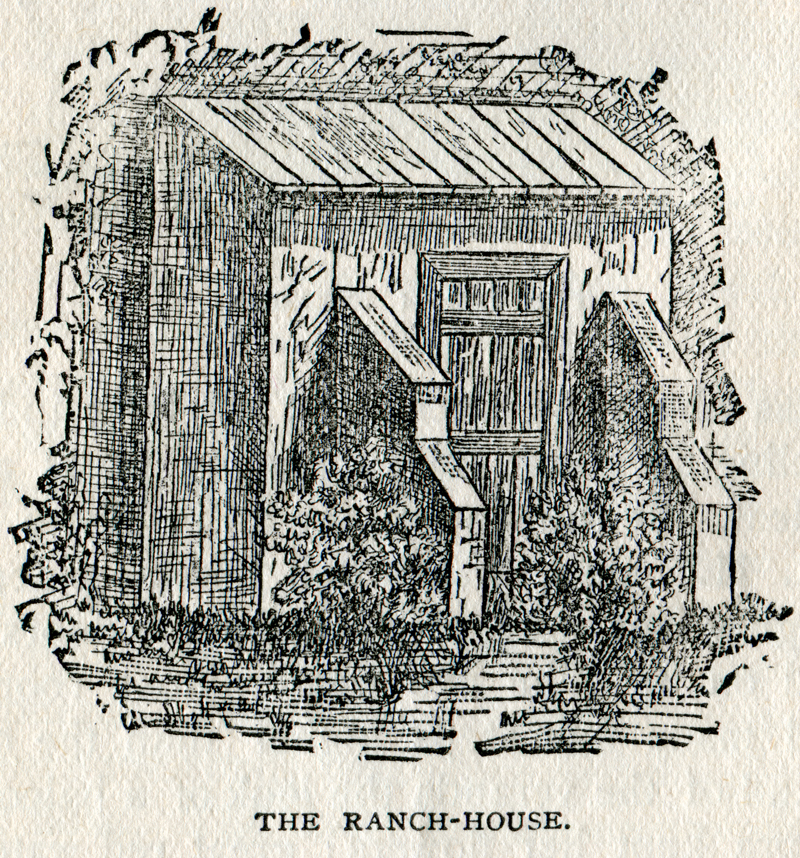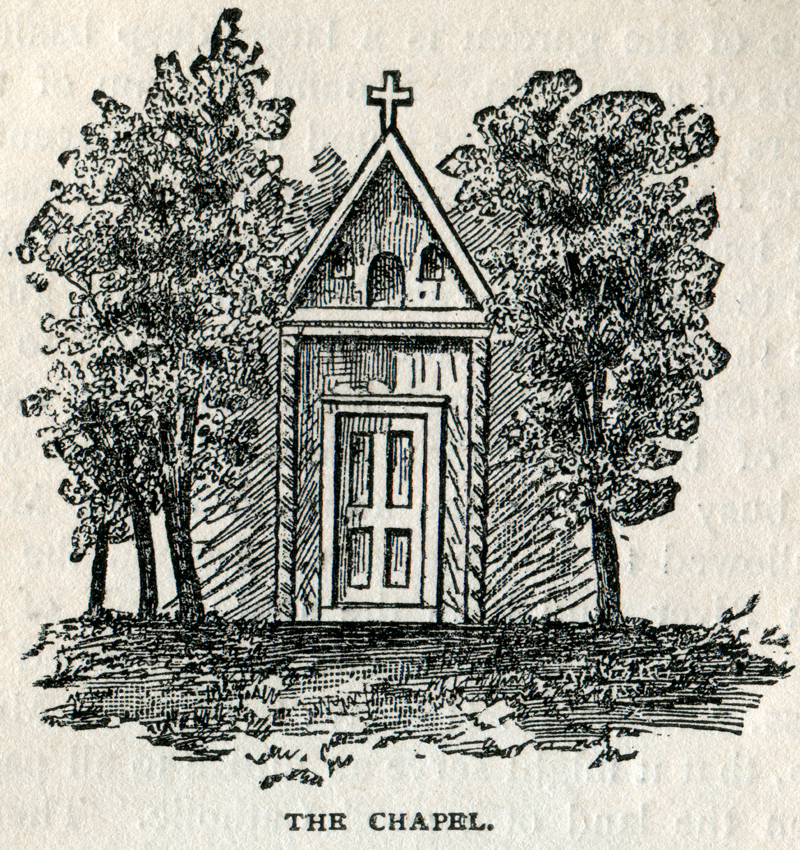|
|
Ramona's Home:
A Visit to the Camulos Ranch, and to Scenes Described by "H.H."
By Edwards Roberts.
The San Francisco Chronicle, 1886.
This version republished as an epilogue in Little, Brown & Co.'s 1905 edition of "Ramona." Illustrations as published.
|
Camulos Ranch (Santa Clara Valley), In traveling from Tucson to the Santa Clara valley a marked change is experienced. Here in California there is not even a suggestion of the barren wastes that are so apt to oppress one in Arizona. From Newhall, where just now all the talk is in regard to the proposed railroad[1], to Camulos, the Santa Clara valley is a garden. By the roadside is field after field of grain. It is strange there was never before this a railroad built into such a fruitful region. If I were an Easterner, and had never seen California, and should see it as I do now, robed in its bright spring dress, sweet to smell, beautiful to look upon, as warm and pleasant as June is in New England, I should ever after be a devoted admirer of the State, and could always be ready to believe and indorse all the pleasant things said in regard to it. But it is not as a stranger that I return to California, nor do I seek this overland route simply because of its picturesqueness. What I sought is this which I have found, — the Camulos ranch, the home of Ramona, whom "H.H."[2] created, and described as living with the Señora Moreno in this house from which I write to-night. Yes, here lived the heroine of the novel[3] which many call the American novel, long watched for and now come at last. Here, before the cool, shaded veranda on which I sit is the courtyard; here is Felipe's room, and there Ramona's, and there the Señora's. I can see the kitchen, from which to the dining-room there was always a procession of children carrying smoking-hot dishes to the Señora's table. Where I am sitting old Juan Can used to lounge, with his legs stretched out before him, and his dog at his feet. Near by is the south veranda, the Señora's own, on which opened the room the good Father Salviederra used always to occupy; beyond that is the garden, "always a mass of verdure," and in which is the chapel; in other directions are the olive, almond, and orange groves. It is all as Mrs. Jackson, in her novel of "Ramona," describes it. One recognizes at once the various places where this and that scene was enacted, and the characters of the story become living realities. Webmaster's Notes to Part 1. 1. The spur line from Saugus to Ventura opened in 1887, one year after this was written. 2. Helen Hunt Jackson went by "H.H." and was so popular, there would have been no confusion about whom the writer is referring. 3. Jackson's characters were fictional, and as for the Del Valle family's Rancho Camulos as the setting for the novel, it probably was — even though the author spent no more than two hours there, two years earlier (see Note 2 to Part 4). However, the purpose of boosterish press such as this — masquerading as journalism and published as the final chapter of the "Ramona" book itself — was to foster tourism and commerce, and to attract Easterners to the budding and highly speculative Southern California real estate market. It purposefully blurs the line between the real and the fictionalized ideal: Come to California and you'll see the actual places you just read about. The Del Valle family capitalized on the phenomenon, adopting the Home of Ramona Brand trademark for its agricultural products. The Camulos. The Camulos ranch comprises fourteen hundred acres of farm and fruit land, and is about eighteen miles west of Newhall. The property was bought by the husband of the present owner, who is constantly reminding one of the Señora Moreno, and the house was built nearly thirty-one years ago. The best-known product of the Camulos is its olives; and next to these are its oranges, lemons, and wines. "The house was of adobe, low, with a wide veranda on the three sides of the inner court, and a still broader one across the entire front, which looked to the south. These verandas, especially those on the inner court, were supplementary rooms to the house. The greater part of the family life went on in them. … All the kitchen work, except the actual cooking, was done here, in front of the kitchen doors and windows. Babies slept, were washed, sat in dirt, and played on the verandas. The women said their prayers, took their naps, and wove their lace there. The herdsmen and shepherds smoked there, lounged there, trained their dogs there; there the young made love and the old dozed." And it is the same now. The court is open on the east, and that side is formed by a grove of orange-trees. In the centre of the little square, set about with rose-bushes and a few trees, is a small fountain basin; and past this the maids and children pass and repass a score of times a day, on their way from the dining-room, on the south side of the court, to the kitchen on the north. There being no hotel in this part of the valley,[1] the Camulos is often filled with belated strangers or visited by those desirous of seeing what an old-time Spanish ranch is like. The household is composed of nearly twenty people, related to the Señora. They are all acquainted with Ramona, and regret not being able to show one the original of that lovely character. "Many who come here," I am told, "do not believe that we are not the ones Mrs. Jackson described. They ask for Ramona and the Señora Moreno, and will not believe we are not the ones they wish to see. We remember when Mrs. Jackson came. She did not remain long; and our Señora,[2] who, we are told, is so much like the Señora Moreno, was then away."
Webmaster's Notes to Part 2. 1. The hotel in nearby Piru is believed to have opened in the early 1870s. 2. The Señora at Camulos at the time was the former Ysabel Varela, who married Ygnacio del Valle in 1852, outlived him, and became Ysabel del Valle Cram. Señora Moreno, and for that matter Ramona, are fictional characters in the novel. The Ranch-House.
The garden nearest the south side of the house is to nearly all who visit the ranch the most delightful feature of the place. It is barely an acre in extent, but is filled with trees and shrubs that give forth a rich fragrance, and inhabited by many birds. In the centre of the garden is a large, deep basin, into which fall the waters of a fountain. Around the rim of the basin are pots of flowers and curiosities found in the adjacent hills. To the left of the fountain and extending down the east side of the garden is a long grape arbor, overhung with vines. It leads to the brook that runs in the shade of some old gnarled willow-trees, where the maids are made, in "Ramona," to do the washing of the Señora's luxurious household. It was there, too, at the foot of the arbor, that Alessandro first saw Ramona, as she was busy washing the altar-cloth that Margarita had carelessly allowed to become torn. Beyond the brook is the Santa Clara River, and from the south bank of that shallow stream rises a group of hills, one being capped with a huge wooden cross, which "H.H." says the Señora Moreno caused to be set up, that it might serve as notice to all passers-by that they were on the land of a good Catholic. There is another of these crosses on the hill to the north of the ranch. The Chapel.
Webmaster's Notes to Part 4. 1. Or, perhaps illustrating the Del Valles' gift at replicating the things they read in the book. 2. Jackson spent much more time – several days – with Antonio and Mariana Coronel at their mansion in Los Angeles. In fact, it was Mariana Coronel who, according to Harris Newmark ("Sixty Years in Southern California, 1853-1913"), gave Jackson the idea of using Camulos as a backdrop for her novel. "Disappointed in not finding the Del Valles at home," Newmark writes, "and consequently seeing the imagined headquarters for Ramona for but an hour or two, she was compelled to rely upon her Los Angeles hostess [M. Coronel] for many of the interesting and singularly accurate details." According to Newmark, Jackson roughed out her notes on the Coronels' veranda in Los Angeles and later gave the Señora the first copy of the novel. While developing the story, Jackson also visited "all the well-known Indian rancherias between San Diego and Monterey, in addition to the twenty-one Franciscan Missions," Newmark writes. Bells From Old Spain.
The surroundings of Camulos are now most beautiful and attractive. The hillsides are literally covered with wild-flowers and thickets of wild mustard, while the river winds down the long wide valley like a silver thread. Lambs and frisky kids are bleating in the corrals; the swallows are building their nests of mud under the eaves of the barn; the almond blossoms of a few weeks ago have fallen, and in their place are hairy little bodies that daily grow in size; on the orange-trees are clustered of golden fruit and white blossoms; the roses are in full bloom; the grasses are green. All nature is fresh and fair; the season is that in which Ramona's new life began.
|
SEE ALSO:
Camulos Visit,
SoCal Observations (Odell 1939)
Portraits x2
Full Text
HHJ Gravesite 1912
I Knew Ramona, by Jose Jesus Lopez
Roberts Story 1886
Antonio Coronel Bio, HSSC 1900
"Narrow Trail" by Wyeth 1939
|
The site owner makes no assertions as to ownership of any original copyrights to digitized images. However, these images are intended for Personal or Research use only. Any other kind of use, including but not limited to commercial or scholarly publication in any medium or format, public exhibition, or use online or in a web site, may be subject to additional restrictions including but not limited to the copyrights held by parties other than the site owner. USERS ARE SOLELY RESPONSIBLE for determining the existence of such rights and for obtaining any permissions and/or paying associated fees necessary for the proposed use.











